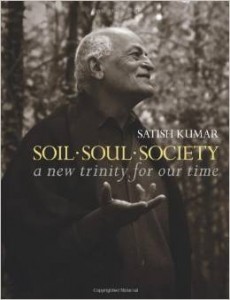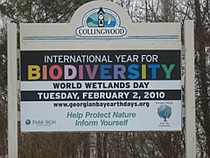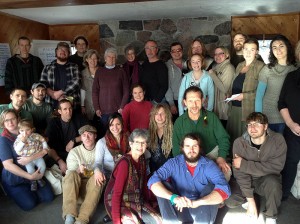Archive for the ‘Nature Articles’ Category
Eating Well: the Resurgence of Organic Farming in Georgian Bay
“With the average age of farmers steadily increasing and the massive environmental impact agriculture can have on the life-support systems of the earth, it became apparent to me that we need more ecological food producers than ever before.” – Mike Reid of Kolapore Gardens
 There is a real revitalization of our rural area happening. I had the chance to visit two farms to take a look at how their newly established ventures were progressing, and I was impressed to see and feel their dedication and passion for what they wish to achieve on their land. Amy and Patrick’s farm is high on a hill overlooking Heathcote and the Beaver Valley while Mike’s farm is nestled away next to Kolapore Wilderness area. What links Patrick and Amy Kitchen’s Sideroad Natural Farm with Mike Reid’s Kolapore Gardens is their mutual emphasis on growing food organically and respecting the fragility of our biosphere.
There is a real revitalization of our rural area happening. I had the chance to visit two farms to take a look at how their newly established ventures were progressing, and I was impressed to see and feel their dedication and passion for what they wish to achieve on their land. Amy and Patrick’s farm is high on a hill overlooking Heathcote and the Beaver Valley while Mike’s farm is nestled away next to Kolapore Wilderness area. What links Patrick and Amy Kitchen’s Sideroad Natural Farm with Mike Reid’s Kolapore Gardens is their mutual emphasis on growing food organically and respecting the fragility of our biosphere.
After having lived in the Beaver Valley for 34 years I have begun to notice a recurring story in our area: young people are rapidly moving in from other places in the country. Patrick and Amy had gone to school out at Simon Fraser University in British Columbia but found it difficult to buy land out west. The fact that family was in Ontario made the choice uncomplicated: good land that was far less expensive than could be found in B.C.. Mike also came to Kolapore from Godrich, and he also has family close by.
Visits to the farms revealed real care, determination and love for the land. It hasn’t been easy setting up shop either. Both farms needed infrastructure and the ubiquitous poly-tunnel was built on both farms. Why are these plastic greenhouses showing up everywhere? It has a lot to do with climate change. In the past 10 years I’ve watched knowledgeable older farmers build these greenhouse-tunnels to be able to insure that the now increasingly common severity of weather doesn’t destroy their crops. They simply can’t take on the plethora of risks to their livelihood due to climate destabilization without making necessary changes to how they grow their food. Water has to be plentiful so Sideroad Natural Farm took up the task of putting in two ponds for irrigation of the crops. Climate change can pose a real challenge when water scarcity can be definitely an issue.
Both farms try to sell their vegetables at our farmers’ markets that range from potatoes, spinach to the more exotic kohlrabi. Sideroad Natural Farm also prides itself on the flowers it grows, as Amy is also a fine flower arranger, and flower decorations for weddings is an expanding part of their business. Patrick showed me a dozen hearty healthy pigs while Mike Reid’s Kolapore Gardens sells free-range eggs. At the moment the pigs are fed with non-GMO foods and the Kolapore chickens have organic grains. Both farms let their animals forage. These farms are as far as you can get from the industrial-type farm that Canada has been so criticized for recently by World Animal Protection. If you like vegetables you’ll be able to buy arugula, leeks, broccoli, squash, tomatoes, kale and more.
For some time now community-supported-agriculture (CSA) has been extremely important for organic farmers. What does CSA mean? By committing to buying a basket of food for a set number of weeks it allows the farmer to have an ‘insurance policy’ as they can depend on a basic weekly salary by knowing how many baskets of food will be bought. The contents of the basket will change week to week. It is much more than that: communities become more self-reliant when local purchasing of food becomes a reality. For new farmers this is also a way to be a part of the community. Amy feels a connection already to our area. By and large these farms prosper when communities buy and in many instances volunteer to help grow the food. People who volunteer can be local or from other countries who wish to get a flavour of rural farming life. Amy agrees: “Support for local, organic food continues to grow. It’s an exciting time to be farming and we can’t wait to get out in the field this spring.”
Please visit the websites www.sideroadnaturalfarm.com and www.kolaporegardens.com to learn more about our wonderful farmers and their organic food. Support them by being a part of the CSA initiative or visit the farmers at a few of the farmers’ markets located in Collingwood, Clarksburg, Toronto and Meaford.
2015 Permaculture Design Course Internships
Nova Scotia Permaculture is pleased to announce the following summer classes. It is a great opportunity to learn the basics of permaculture design over 8 weeks.
We are once again offering a PDC on a work trade basis(no fee, no stipend) over a period of six(minimum, if you just can’t stay eight) to eight weeks(which we favor), running through June to the end of July, and will repeat it in September/ October if we get firm sign up commitments.We are limiting the course to a maximum of five, so don’t hesitate too long in signing up. Pretty close to full attendance will be required to receive a PDC certificate.
This will be a very hands on experience, including smaller design projects on the site, general farm work(chores, goat milking, hay making, maintenance etc) helping/cooking in the kitchen, as well as substantial market gardening time. (You can learn a lot just by walking around here.)This will be balanced by classes, presentations(some by you!) and field trips, as well as time doing design projects. Although the schedule will be intensive, especially with the long days of summer,there will also be time for personal study/ reading, and at least one free day per week. We will provide food and lodging, though if you have specialized dietary requirements(we’re omnivores, and 98% of the meat is from here), that will be your own responsibility. We are mostly interested in self-motivated folks with some work experience(some basic knowledge of hand & small power tools very useful), although attitude and willingness count alot too. We will ask that you leave your cell phones and earphones/ipods behind while were working or studying together, so be fully aware of that, please. Further details/ info will come later in the process, and you can read our MOP internships page for further details.
If you are interested, please contact me, and include some basic personal info about yourself, your interests and experience, and why you want to do this. Thanks, Alex
contact: alexdenicola at hotmail.com
1217 Belmont rd. RR2 Newport B0N2A0
Please see the website: http://www.novascotiapermaculture.net/
Transition Meaford and Transition Collingwood create blueprint for healthy community
“In the leaking ship that we’ve made of our planet, the Transition movement is like a flotilla of life rafts. And they’ve come not to pull us off the earth, but to help us patch it and make it right.”
– Bill McKibben
In early December fourteen people from the Meaford and Beaver Valley area came together to continue to work on making their community a healthier and more self-reliant place to live. I had attended a meeting of Transition Meaford two years previously and found that there is a growing interest amongst the townspeople in creating a more engaged society so that people and the rest of Nature can flourish.
In 2013, Meaford Council adopted the recommendation by Transition Meaford to have an Earth Week. This took place in April 2014, beginning with a spring clean-up at Memorial Park, and ending with a Re-use Fair. Lindy Iversen and other Transition Meaford people were on hand to volunteer. The tradition will continue in 2015.
Transition Meaford has been involved in a number of other projects. The group has played a significant part in the community garden at the high school. Films for Thought was set up to promote greater awareness of social justice and ecology around the world, through screenings of films that gave the community insight into ongoing struggles related to food, water, community design and waste. The Bee and Butterfly Habitat Initiative brought to the forefront the plight of our pollinators.
The group would love to meet other Meaford and area residents who care about the future of their community. Meetings are held on the second Wednesday of each month at 7pm at EcoInhabit on Old Highway 26, east of Meaford. Next meeting is on January 14th. To find out more, visit www.transitionmeaford.org
Live in Collingwood? Transition Collingwood’s initiatives can be found at transitioncollingood.com
How did the Transition movement come about?
Back in 2005 people in Totnes, UK began to ask themselves how they could thrive in the face of climate instability and oil scarcity, and thus the first Transition Town was born. The vision of a resilient community that could support itself culturally and agriculturally despite the problems raised by these twin threats inspired the Transition Network, which has spread within ten years to encompass the world. By not having any political affiliations the movement has been able to gain the trust of entire communities. This has led to close working with all segments of society.
To the amazement of founder Rob Hopkins, the accomplishments of the expanding Transition Community now include social justice issues as well. Places like Brazil and India are more interested in alleviating poverty and empowering women than discussing northern concerns for climate change mitigation strategies. The Transition movement is embracing more and more topics that impact the health of communities, to create a Transition Culture that looks at the causes of consumerism and the growth economy and changes the very soil of the community’s culture and inner life. It transitions towns to the ‘caring economy’. (It must be noted that the opposite of this is shown in the lack of balance and compassion in Canada’s skewed oil-based economy.)
Several towns and cities now have their own local currencies, which encourage their communities to buy locally produced goods and thereby recycle their money to keep their own businesses vibrant. The benefits come full circle. The city of Bristol, in Britain, even pays its mayor in Bristol Pounds! Having a local currency has fostered a deep sense of trust in the community. Bristol has now won the prestigious award of European Green Capital 2015.
Please visit www.transitionnetwork.org to learn more about the Transition movement.
Kimbercote Farm’s AGM brings out the best in our community
Kimbercote Farm is located on a hill that looks down on the Beaver Valley and beyond. For the past 40 years it has provided physical and spiritual space for people to grow. It’s brochure describes the Farm as a “Centre for social and environmental justice in the heart of the Beaver Valley”. The Farm’s 110 acres has provided the Georgian Bay and Southern Ontario communities with a unique opportunity to experience a country setting for events, retreats and a vast array of discussions that take place because of the dedicated volunteers who have kept Kimbercote alive and well with their creative zeal for four decades. Although the focus of the Farm’s activities may have shifted through the decades social justice has always been the bedrock for all its charitable not-for-profit work. As the meaning of social justice has expanded in the last 40 years, so has inclusion of nature stewardship become more important to the Farm. Gardening, permaculture, forest ecology programs, the truly hands-on efforts by Sticks & Stones Wilderness School plus Headwaters Gathering groups have put new meaning into conservation education and practices in sustainability. And so Kimbercote has championed and nurtured aboriginal culture, organic agriculture, faith/spiritual groups, children, families as well as men and women’s retreat groups. The farmhouse has been the key to letting the Farm host year round 25 guests at a time plus tents.
The Annual General Meeting on December 7 brought out 60 individuals of all age groups. No one has ever seen such a large group come out to such a meeting at the Farm. Kimbercote Farm is in financial trouble but it is not without its friends. This place means a great deal to many people. This year’s AGM brought out the people for the love of a Georgian Bay community icon. The usual AGM business of voting in board members was not the focus of the meeting so much as an inspired discussion on the future for the charity. Although the current debt is quite small fewer groups are renting the space in an ageing farmhouse but the maintenance of the facilities keeps on growing.
The members attending the meeting were asked to have small discussion groups and write out their suggestions to be presented to the new board of directors who will then make the critical decisions as to the Farm’s future. Three proposals were given to the group. Naturally the community wishes to see a vibrant and financially secure future for the Farm. Thoughts of renting out the farmhouse on a yearly lease, seeing the sale of some acreage to conservation groups and having Sticks & Stones Wilderness School play a more active role in programming may be the starting point for the end of the charity’s woes.
The crisis now being experienced can transform Kimbercote into the Centre for Community and Ecology, as mentioned at the AGM, and give true meaning and tangible direction to the founders’s original goals of social justice. A possibility/option exists to sell the facility and purchase a new one which puts a major focus onto program development for youth and families, provide dialogue with other communities and “support community/ecology locally, regionally and provincially.” Programs would start in early 2015 for children. SSWS would share programming efforts also. A legal trust would also be created to insure “trust funds go to social justice innovators if the sale of property occurs in the future.”
The other option spells the sale of the land and basically giving the money to like-minded foundations. The new Board’s occupation will be one of courage and vision. We wish them wisdom. It is more than just putting into place short term financial solutions. Kimbercote’s core community needs to now put into play the creative ideas and passion to bring it to 2050.
If you wish to learn more about the Farm and perhaps help in various ways please visit:
www.kimbercote.org or write to info@kimbercote.org
The People’s Climate March
“We can no longer continue feeding our addiction to fossil fuels as if there were no tomorrow. For there will be no tomorrow.” – Desmond Tutu
 The People’s Climate March on September 21st was more than a protest. The World Council of Churches, individuals and many universities are now divesting from fossil fuels. If the heirs to the John D. Rockefeller oil fortune are now committed to getting rid of over $800,000,000 in oil and gas stocks, what’s next? Rob Hopkins, founder of the Transition Network, had this to say: “The People’s Climate March made it clear that while some may choose to retreat from the inevitability of change, many more are embracing that change with passion, creativity and an unstoppable force.”
The People’s Climate March on September 21st was more than a protest. The World Council of Churches, individuals and many universities are now divesting from fossil fuels. If the heirs to the John D. Rockefeller oil fortune are now committed to getting rid of over $800,000,000 in oil and gas stocks, what’s next? Rob Hopkins, founder of the Transition Network, had this to say: “The People’s Climate March made it clear that while some may choose to retreat from the inevitability of change, many more are embracing that change with passion, creativity and an unstoppable force.”
That the UN Secretary-General, Ban Ki-moon, came to the People’s Climate Rally in New York and walked with conservationists such as Jane Goodall is unprecedented. (Please see www.peoplesclimate.org and https://vimeo.com/106898420) Although the walk I attended consisted of just 20 people in a small town, those same people vowed to meet regularly, and the next gathering was held just a week later to discuss how to engage the people who are most vulnerable to climate instability: those aged under 30.
The Climate Summit at the UN on September 23rd brought world ‘leaders’ to the table in order to establish a renewed action plan to combat climate instability. Only a few heads of state did not show up. On September 22nd Parliament’s Question Period was spent trying to find out why Stephen Harper was not going to attend the UN Climate Summit. Instead of giving a direct answer to the opposition party’s request, a government MP read out prepared bureaucratic statements that gave false accounts of Canada’s current scientific efforts in reducing greenhouse gas emissions. This was on the day after more than 600,000 people, including many First Nations Canadians, marched for climate action. Please see http://thetyee.ca/Video/2014/09/25/Idle-No-More-Organizers-At-NYC-Climate-March/. The closest march to Collingwood and Meaford took place in Owen Sound.
This Canadian government is the only one in the world that has withdrawn from its treaty obligations described in the Kyoto Protocol. Recent scientific analysis shows that CO2 is rising faster than it has in nearly 40 years, but of course this prime minister was not going to appear at a summit that calls for fundamental reductions in CO2 emissions. He and his caucus are completely blinded by oil revenue.
Climate change will ravage this nation’s economy, our biodiversity and the people of Canada within less than 100 years. The largest climate march in history was meant to finally kick-start the world’s rebuff of fossil-fuel usage. Be part of that solution and divest your fossil energy stocks.
Leaders must put people before politics
By David Suzuki

Credit: Intiaz Rahim via Flickr
When we elect people to office, we give them power to make and enact decisions on our behalf. They should have a vision that extends beyond the next election and the latest Dow Jones average — to our children and grandchildren.
We expect our leaders to have a clear picture of our world and the conditions necessary for human life and well-being. If they don’t, how can they make informed decisions? So let me outline some simple, scientifically validated truths about us and the world we live in — truths that should guide our political decisions.
We are, above all else, biological beings, with an absolute need for clean air from the moment of birth to the last death rattle. We take air deep into our lungs and filter whatever’s in it. Plants on land and in the ocean take in the greenhouse gas carbon dioxide and release oxygen during photosynthesis, creating the atmosphere we depend on.
We are about 60 per cent water by weight, so we need clean water to be healthy. When water falls to Earth, it’s filtered through tree and other plant roots, soil fungi and bacteria, cleansing it so it’s safe to drink.
All the energy in our bodies that we use to move, grow and reproduce is sunlight captured by plants in photosynthesis and converted to chemical energy, which we ingest. We eat plants and animals for our nourishment, so whatever they’re exposed to ends up in our bodies. We need clean soil to give us clean food.
These are basic, biological facts and should be the prism through which any decision is made at individual, corporate or government levels. Protection of air, water, soil and the web of life should be the highest social, political and economic priority.
We’re also social animals. Scientists have shown that love during childhood is essential for healthy development. Children who are deprived of love at critical points can develop a variety of physical and psychological deficits. To avoid those, we have to work for strong families and supportive communities, full employment, justice, greater income and gender equity and freedom from terror, genocide and war.
Finally, we are spiritual creatures who require sacred places, a sense of belonging to the world and a recognition that we are not in charge of nature, but dependent on the biosphere for our health and well-being. We are not outside of nature; we are part of it.
To be fully healthy and human, our most elemental needs are biological, social and spiritual. Politicians ought to know this. Their role is to protect and enhance those necessities of life; otherwise there is no vision, direction or leadership.
That’s why it’s absurd for a politician or government representative to speak about any aspect of the economy without acknowledging the threat of human-induced climate change. Many oppose doing anything on ideological grounds, but the science is overwhelming and compelling, and the need for action is clear. What can you say about “leaders” who choose to ignore the best available evidence to the detriment of the people they are elected to represent?
Surely those who act only for short-term economic gain, imposing destructive consequences on generations to come, must be held responsible. We must also consider the consequences of rapid and excessive exploitation of fossil fuels on the world’s poorest people, who have done little to create climate change but are most affected by it.
Even though Canada ratified the legally binding Kyoto Protocol, which spelled out our obligations to reduce the risk of climate change, many of our “leaders” have wilfully ignored scientific evidence and urgent calls to meet the protocol’s targets, and Canada eventually abandoned the agreement. What should we call that?
And what can we say about “leaders” who can see something is wrong and have the means to respond but choose not to? This is what Canada is doing — in the face of overwhelming evidence and pleading of other industrialized nations.
Our elected representatives deserve respect for their commitment. But the elevated status and power of politicians also carries responsibilities. Many are abrogating those responsibilities for ideological reasons that have nothing to do with our well-being.
Summer readings that inspire
“Compassion for ourselves gives rise to the power to transform resentment into forgiveness, hatred into friendliness, and fear into respect for all beings.”
Jack Kornfield
Although the summer is coming to a close, there is still time to sit down in a comfortable chair or by the Bay to enjoy, as well as be inspired by, two books that might be the very bridge to take you into a happy autumn.
This summer I was fortunate to have spent three days with one of the world’s finest spiritual/eco writers and activists, Satish Kumar. I had followed Satish’s work in Resurgence & Ecologist magazine, and when I had the opportunity to be part of a small gathering that included Satish it enabled me to further understand the depth of his thoughts regarding our planet.
Born in India 78 years ago he left his family when he was 9 to spend 9 years living in a monastery. Inspired by Gandhi’s vision of peace and non-violence he walked penniless for 8,000 miles to deliver the message for a nuclear-free Earth.
Satish’s deep interest in Buddhism is reflected in his vast writings and discussions.  “Soil, Soul, Society: a new trinity for our time” is his latest book to help turn a world away from violence. By expanding the notion of non-violence between people (Society) to embrace the Earth community (Soil) as well as the individual’s spiritual life (Soul), Satish is able to do something quite remarkable: all of life is brought into a sacred covenant to pursue happiness. Speciesism, or the assumption of human superiority and dominance over other species, the author reminds us, has brought us to the crises we now find ourselves facing. Reminding us that we are part of a benevolent universe that gives freely to support life, Satish relates how he gently confronted modern western society’s vision of globalization when he was invited to speak to the students of the London School of Economics. Often western society believes that business is the salvation for this planet, but by doing so it forgets the very foundation for business to take place: ecology. We learn that ecology is not taught at the LSE, and so Satish asked that the school be renamed the London School of Ecology and Economics to reflect a healthy curriculum.
“Soil, Soul, Society: a new trinity for our time” is his latest book to help turn a world away from violence. By expanding the notion of non-violence between people (Society) to embrace the Earth community (Soil) as well as the individual’s spiritual life (Soul), Satish is able to do something quite remarkable: all of life is brought into a sacred covenant to pursue happiness. Speciesism, or the assumption of human superiority and dominance over other species, the author reminds us, has brought us to the crises we now find ourselves facing. Reminding us that we are part of a benevolent universe that gives freely to support life, Satish relates how he gently confronted modern western society’s vision of globalization when he was invited to speak to the students of the London School of Economics. Often western society believes that business is the salvation for this planet, but by doing so it forgets the very foundation for business to take place: ecology. We learn that ecology is not taught at the LSE, and so Satish asked that the school be renamed the London School of Ecology and Economics to reflect a healthy curriculum.
 One of the finest photography/quotation books on Tibet, India, Bhutan and Nepal is called “Buddhist Offerings 365 Days” by Danielle and Olivier Follmi. The authors are renowned for their incredible portraits of Himalayan life. Humans are intrinsically part of their landscape, and this magnificent collage of all forms of life is balanced with insightful quotes from people including the 14th Dalai Lama, Jack Kornfield and Arnaud Desjardins among others. The book is a true celebration of happiness. Desjardins is quoted:”The law commands us to do what we would do naturally if we only had love. The Way consists of finding that love, which then becomes the law.”
One of the finest photography/quotation books on Tibet, India, Bhutan and Nepal is called “Buddhist Offerings 365 Days” by Danielle and Olivier Follmi. The authors are renowned for their incredible portraits of Himalayan life. Humans are intrinsically part of their landscape, and this magnificent collage of all forms of life is balanced with insightful quotes from people including the 14th Dalai Lama, Jack Kornfield and Arnaud Desjardins among others. The book is a true celebration of happiness. Desjardins is quoted:”The law commands us to do what we would do naturally if we only had love. The Way consists of finding that love, which then becomes the law.”
July 11 is World Population Day
“We must rapidly bring the world population under control, reducing the growth rate to zero or making it negative.” Paul R. Ehrlich
The world’s population passed 5 billion on July 11, 1987. The UN decided in 1989 to have an annual discussion regarding human population issues, but the UN is reluctant to spell out the multitude of dangers that comes with an out of control population. In many parts of the world birth control is a taboo subject, and the UN tries to get around this by often portraying the population crisis as solely a social justice issue, which in part it is, but it is far from the whole picture.
What is a key driver for over consumption, food and water scarcity, climate change, biodiversity loss, mass migration, impoverishment of lands and oceans, war and human poverty? Population is a key driver and the stabilization and steady decrease in births will determine whether or not civilization will survive by the end of this century. See Paul Ehrlich’s “Can a collapse of global civilization be avoided?” at the Proceedings of the Royal Society.
http://rspb.royalsocietypublishing.org/content/280/1754/20122845.full
In 1810 there were 1 billion people on the planet, 2 billion in 1930, 2.5 billion by 1950, and in 2011, 7 billion humans inhabited the Earth. Every day 227,000 people are added to the planet’s population or the equivalent of Toronto’s population is born every 13 days. By 2050 demographers project the world’s population to be over 9 billion humans.
Many times a rising population is the rationale behind the arguments given by biotechnology companies for their products: the world needs their pesticides and their seeds to feed the world. Two billion hungry people may disagree, and by making it increasingly more difficult for the poorest people to harvest their own seeds, these multinational corporations are further raising food prices as well as the spectre of mass starvation. Many bee populations are disappearing because of those products.
It is not only the poorest countries that can least afford population gains. Britain is in deep trouble. Britain is half the size of France yet it has the highest fertility rate in Europe. Rising carbon dioxide levels fueled by an ever increasing world population is already causing unprecedented flooding, making it more difficult to farm and to find enough land to build more homes.
North Americans have the largest carbon footprint on the planet. Having fewer children and a vegetarian diet will make a huge difference to that footprint.
Watching out for our snapping turtles
“Snapping turtles face an uncertain future in Ontario because we have paved over 70 percent of southern Ontario’s wetlands and created corridors of death with our roads and highways.” – Sue Carstairs, Medical Director, Kawartha Turtle Trauma Centre
Until recently, many of us expected to see in June a snapping turtle laying her clutch of maybe 40 eggs at the roadside. Certainly this has been the case near the Beaver River, where female turtles come up from the river and make their way onto the gravel. It is easy to then see how impressive is Canada’s largest freshwater turtle, Chelydra serpentina. Tragically, 40 million years of success may be coming to an end. The odds are slim that a baby snapping turtle will reach maturity (at 15–20 years). It is estimated that only 1 in 1,400 eggs achieves this. There are many predators that dig up the eggs. However, it is we who have brought the snapping turtle and other reptiles to the edge of extinction.
The David Suzuki Foundation has warned Ontario’s Ministry of Natural Resources that it must ban all hunting of snapping turtles, as Quebec and Nova Scotia have, and apply the precautionary principle to its conservation work. (See ‘Road to Extinction’ at davidsuzuki.org) As of today, anyone with a small game or fishing licence can take two snapping turtles each day. Although commercial harvesting of turtles is illegal, the dwindling snapping turtle population needs much better protection than simply being listed “of special concern” under Ontario’s Endangered Species Act. Sporting groups have denied that there is a problem, but most scientists disagree, including those who conducted a 40-year study for Ontario’s Species at Risk programme. If the complex toxic mix of habitat loss, boat strikes, road kill, bio-toxic pollution, climate change and the black market is put into a meaningful conservation perspective, we all have to do much better if the snapping turtle is to be saved.
Undoubtably snapping turtles are an important part of their aquatic ecosystem. They like muddy river bottoms and move along them making channels for other creatures to live in. They eat dead fish and mammals as well.
What can you do to help the snapping turtle? Definitely take her off the road and move her in the direction she was going. If you see a turtle laying her eggs, stay near to protect her until she has covered them up, and return her to the wetland. (By the way, it is a myth that she can cut your finger off if she bites you.) If you find an injured turtle, contact Kawartha Turtle Trauma Centre at 705 741 5000.
Warsaw climate summit signals much work to be done before 2015
“Walmart is failing on climate…. The company’s carbon pollution is up 14 percent while it pours millions of dollars into a misleading PR campaign around sustainability and anti-environmental public officials who obstruct solutions to climate disruption.” Sierra Club
In November the UN Climate Conference summit met in Warsaw to continue on going negotiations and see if the world’s nations can limit carbon emissions that are fueling a 2 degree Celsius increase above our pre-industrial temperature. Christiana Figueres, the UN chair of the conference, appealed to coal companies to keep most of the Earth’s coal in the ground and work towards a new vision of renewable sources of energy. Twenty-seven international scientists present at the summit confirmed her concerns by saying that at least 75 percent of coal deposits must be kept in the ground if we are not to exceed our “carbon budget”. (To Ontario’s credit, it is now shutting down its last coal-fired power station.)
The failure of the world’s richest countries to live up to their climate pledges in the wake of the disaster in the Philippines has only created a wider divide between rich and poor. Meanwhile, the decision by 800 people representing trade unions, environmental groups, young people and social organizations to walk out of the Warsaw Conference left the UN meeting at a new low. The summit’s final communiqué speaks of success that will lead us to a fruitful agreement in Paris in 2015 – but where is the map to get us there?
Canada has the dubious distinction of receiving the only “Lifetime Unachievement Award” for its continuing role in blocking and stalling progress at the talks. Canada has become the mouthpiece of many large companies. Following new research in the journal Climatic Change The Guardian newspaper said: “The climate crisis of the 21st century has been caused largely by just 90 companies, which between them produced nearly two-thirds of the greenhouse gas emissions generated since the dawning of the industrial age”.
In the Blue Mountains and Collingwood, what progress has been made in confronting the climate crisis? Although local governments speak about their interest in mending their prodigal ways, little has been accomplished. It is up to young people to make the changes that older people have not been able to achieve in order to beat back devastating climate instability.



